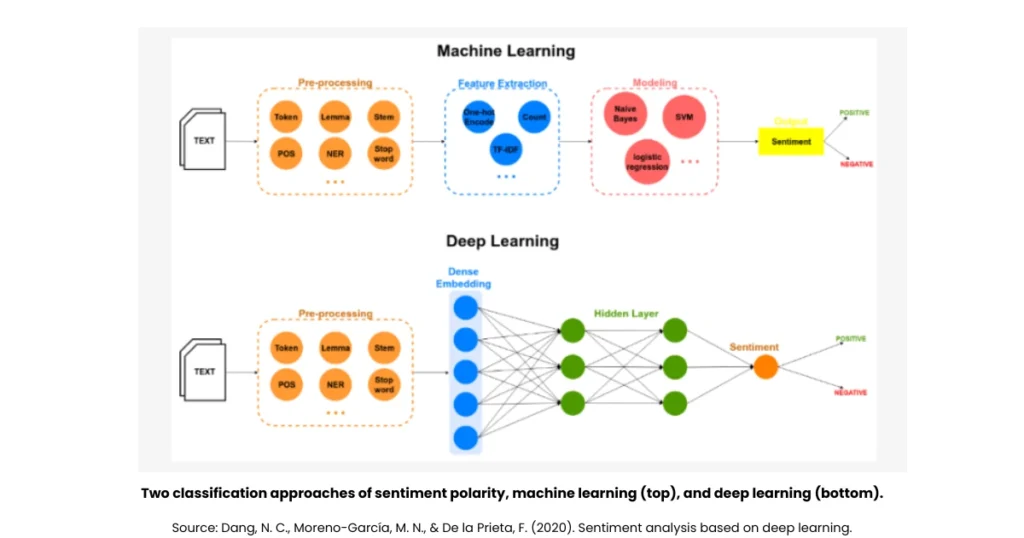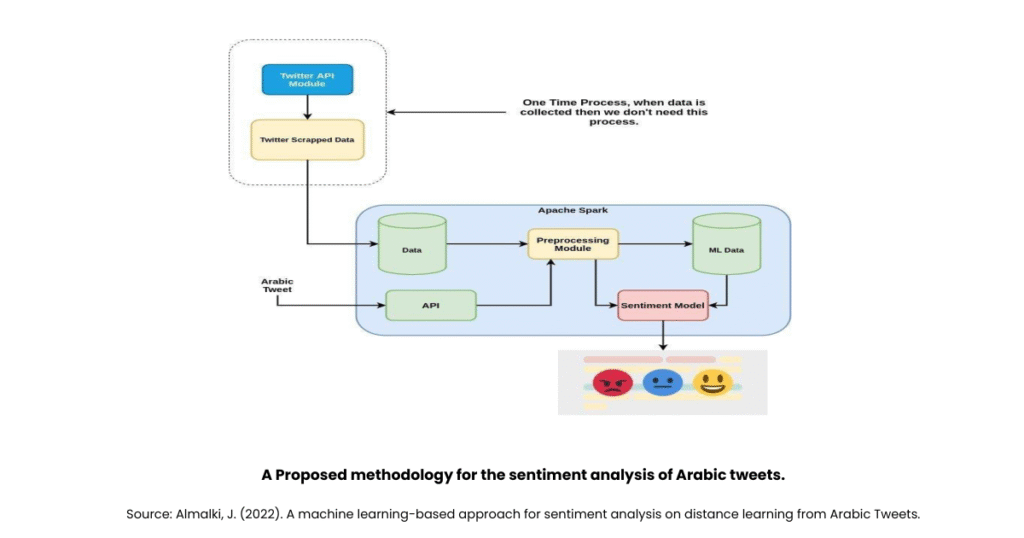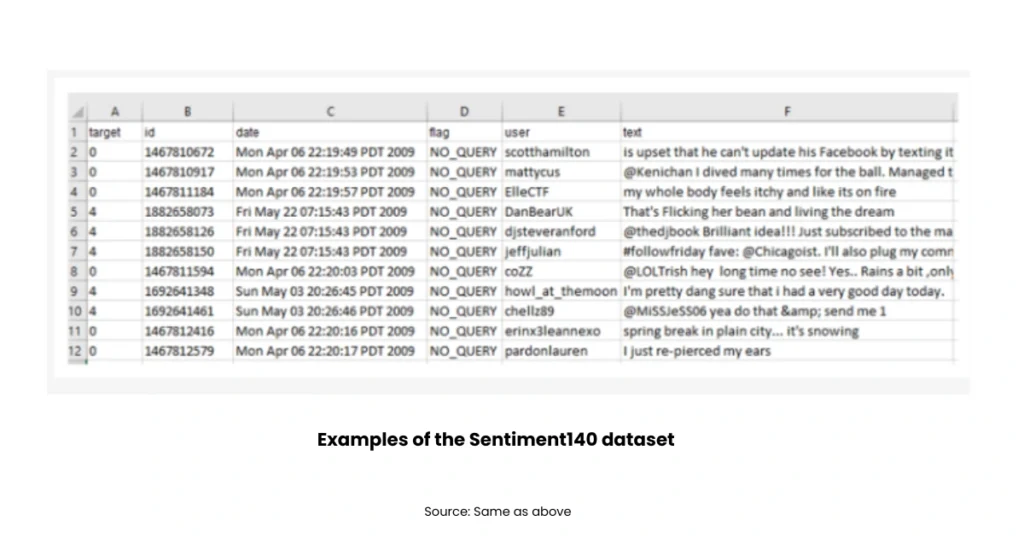Sentiment Analysis Using Machine Learning: Sentiment analysis using machine learning is quickly becoming one of the most talked-about applications of artificial intelligence. Every time someone tweets, writes a review, or posts a comment online, they leave behind digital footprints of their thoughts and emotions.
Businesses, governments, and even researchers love exploring these insights. But here’s the big question: how can machines understand human emotions expressed in words?
That’s exactly where sentiment analysis using machine learning comes in. By using algorithms and data, we can train computers to classify opinions as positive, negative, or neutral. More advanced approaches even detect complex emotions such as joy, anger, or frustration.
In this blog, we’ll unpack the concept step by step, covering the types of sentiment analysis, free sentiment analysis tools, machine learning algorithms, accuracy, and its applications.
What Is Sentiment Analysis Using Machine Learning?
At its core, sentiment analysis answers a simple yet powerful question: What do people feel about a particular subject? Whether it’s a brand, political leader, movie, or policy, the fundamental purpose of sentiment analysis is to decode opinions and emotions from text data.
For example:
- A company like Flipkart might analyse customer reviews to see if a product is well-received.
- Politicians use sentiment data to measure public response during elections.
- Healthcare professionals study patient feedback to improve services.
The main goal is to turn raw unstructured data into actionable insights. According to a study published by Gartner, more than 80% of enterprise data is unstructured. Without sentiment analysis using machine learning, most of this data remains untapped.

Types of Sentiment Analysis
Not all sentiment analysis tasks are created equal. Depending on the need, companies choose different types of sentiment analysis. Let’s break them down:
- Binary Sentiment Analysis
- Classifies text into two categories: positive or negative.
- Example: “The delivery was fast” (positive), “The food was terrible” (negative).
- Fine-Grained Sentiment Analysis
- Goes beyond binary and adds more depth: very positive, positive, neutral, negative, very negative.
- Example: A 5-star Amazon review versus a 2-star review.
- Emotion Detection
- Identifies emotions like happiness, sadness, fear, or anger.
- Social media monitoring often uses this type to track mood shifts.
- Aspect-Based Sentiment Analysis
- Focuses on specific features of a product or service.
- Example: “The phone’s camera is excellent, but the battery life is disappointing.”
- Real-Time Sentiment Analysis
- Analyses opinions as they’re posted online.
- Widely used in financial markets to monitor live reactions to company news or stock changes.
Each of these types of sentiment analysis is important in its own right, and the choice depends on the problem at hand.
How to Do Sentiment Analysis?
So, how do you actually perform sentiment analysis using machine learning? The process involves several steps, each critical to getting accurate results:
- Collect Data
- Gather text data from sources like social media, customer reviews, or survey responses.
- Preprocess the Data
- Clean text by removing stop words, punctuation, and special characters.
- Tokenisation (splitting sentences into words) and stemming/lemmatisation (reducing words to their base form) are applied.
- Select Sentiment Analysis Machine Learning Algorithms
- Depending on the dataset, one can use Naive Bayes, Support Vector Machines, Logistic Regression, or deep learning methods.
- Train the Model
- Feed labelled data into the algorithm so that it learns patterns.
- Test and Evaluate
- Evaluate accuracy using test datasets.
- Deploy for Real-Time Sentiment Analysis
- Use APIs or cloud services to process live data streams, such as Twitter feeds.
This framework is not only useful for companies but also makes for exciting sentiment analysis machine learning projects that students and developers can try.

Read More: Machine Learning Projects For Final Year
Sentiment Analysis Machine Learning Algorithms
A common question is: Which algorithms are best for sentiment analysis? Let’s look at the most widely used sentiment analysis machine learning algorithms:
- Naive Bayes Classifier
- Simple and fast, works well with smaller datasets.
- Good for basic binary classification tasks.
- Support Vector Machines (SVM)
- Effective for high-dimensional data like text.
- Offers good accuracy in many sentiment analysis tasks.
- Logistic Regression
- Straightforward and interpretable.
- Performs well with large datasets.
- Deep Learning Models
- LSTM (Long Short-Term Memory): Captures long-term dependencies in text.
- BERT (Bidirectional Encoder Representations from Transformers): One of the most advanced models for natural language understanding.
Each algorithm comes with its own pros and cons, and the right choice depends on the project’s size and complexity.
Sentiment Analysis Machine Learning Projects
When you start exploring sentiment analysis using machine learning, the natural question that follows is: what kind of projects can I build?
Well, the good news is that sentiment analysis machine learning projects can range from very simple to highly advanced. They can be built using free datasets, open-source libraries, and even cloud-based APIs.
These projects not only help you learn the types of sentiment analysis but also give you practical experience in working with sentiment analysis machine learning algorithms like Naive Bayes, SVM, or even advanced models like BERT.
Types of Sentiment Analysis You Can Explore in Projects
Different projects can focus on different types of sentiment analysis, such as:
- Binary classification (positive or negative reviews).
- Multi-class sentiment detection (very positive, neutral, very negative).
- Emotion detection (happy, sad, angry, etc.).
- Aspect-based analysis (focusing on product features like camera, battery, etc.).
- Real-time sentiment analysis (live tweets or streaming data).
By experimenting with these, you’ll not only learn the fundamentals but also understand what is the fundamental purpose of sentiment analysis in different industries.

Here are few examples:
1. Movie Review Sentiment Analysis
- Dataset: IMDb Movie Review Dataset.
- Task: Classify reviews as positive or negative.
- Tools: Python, Scikit-learn, NLTK, or TextBlob.
2. Twitter Sentiment Analysis
- Dataset: Tweets collected using Twitter API.
- Task: Monitor public opinion on events, brands, or elections.
- Bonus: Build a real-time sentiment analysis dashboard.
3. Political Sentiment Analysis
- Dataset: Twitter or Reddit discussions during elections.
- Task: Analyse voter emotions in real time.
- Challenge: Sarcasm and slang in political discourse.
4. Sentiment Analysis of News Headlines
- Dataset: Public news datasets.
- Task: Detect how headlines influence stock market trends.
- Application: Finance-related predictions.
· Emotion Detection with Deep Learning
- Use LSTM or BERT to detect fine emotions like joy, anger, or sadness.
- Application: Mental health support apps.
5. Real-Time Sentiment Analysis for Stock Prediction
- Combine Twitter API with live stock market feeds.
- Train models to detect market-moving sentiment instantly.
Step-by-Step Guide: How to Do Sentiment Analysis for a Project
Here’s a general workflow that works for most sentiment analysis machine learning projects:
- Collect the Dataset
- Use Kaggle, UCI Machine Learning Repository, or APIs like Twitter, Reddit, or YouTube.
- Preprocess the Data
- Tokenisation, stop word removal, stemming/lemmatisation.
- Handle slang, emojis, and abbreviations.
- Choose Sentiment Analysis Machine Learning Algorithms
- Beginners: Naive Bayes, Logistic Regression, SVM.
- Intermediate/Advanced: LSTM, BERT, Transformers.
- Train and Test the Model
- Split dataset into training and testing.
- Evaluate with accuracy, precision, recall, and F1-score.
- Visualise the Results
- Use word clouds, sentiment distribution graphs, or dashboards.
- Deploy the Project
- Flask/Django for web apps.
- Streamlit for quick dashboards.
- Cloud deployment on AWS, GCP, or Heroku.
Free Sentiment Analysis Tools
Not everyone has to build models from scratch. There are several free sentiment analysis tools available:
- TextBlob – Beginner-friendly and Python-based.
- VADER (Valence Aware Dictionary and sEntiment Reasoner) – Great for social media text.
- NLTK (Natural Language Toolkit) – Powerful, with various NLP functions.
- Hugging Face Transformers – Advanced pre-trained models like BERT, easy to fine-tune.
These tools make it possible for anyone, from students to businesses, to perform sentiment analysis without heavy investment.
How Accurate is Sentiment Analysis?
Here comes the tricky part: how accurate is sentiment analysis really?
Accuracy depends on multiple factors:
- Quality of data – Clean, labelled datasets improve outcomes.
- Chosen algorithm – Deep learning models often outperform traditional methods.
- Contextual challenges – Sarcasm, irony, slang, and multilingual text are still major hurdles.
Studies have shown that well-trained models can achieve 85–90% accuracy. However, human interpretation remains slightly better, especially in detecting sarcasm or cultural nuances.

Applications of Sentiment Analysis
The power of sentiment analysis using machine learning is visible across industries:
- Customer Feedback – Brands analyse product reviews to improve quality.
- Social Media Monitoring – Companies track brand mentions on Twitter or Instagram.
- Market Research – Start-ups gauge reactions to new launches.
- Healthcare – Patient satisfaction surveys are analysed to enhance care.
- Finance – Traders rely on real-time sentiment analysis of news to predict stock movements.
For example, during the Indian elections, several agencies used sentiment analysis to measure voter mood from Twitter conversations.
The Future of Sentiment Analysis
The field is evolving rapidly. With real-time sentiment analysis and advanced AI models, businesses are moving toward more personalised and predictive analytics. In India, where internet users are crossing 800 million, the role of sentiment analysis in e-commerce, politics, and digital marketing will only grow.
On A Final Note…
So, what have we learned? Sentiment analysis using machine learning is all about teaching computers to understand emotions in text. From types of sentiment analysis to free tools and machine learning algorithms, the journey involves a mix of data collection, cleaning, training, and evaluation. While challenges exist, like sarcasm and slang, the accuracy is improving every year.
Whether you’re a student curious about sentiment analysis machine learning projects, a business exploring real-time sentiment analysis, or simply asking, “How accurate is sentiment analysis?” , this field holds enormous potential.
FAQs
Q1. What is the fundamental purpose of sentiment analysis?
It’s to understand people’s opinions, emotions, and attitudes from text data, turning unstructured data into actionable insights.
Q2. How to do sentiment analysis step by step?
Start by collecting data, clean and preprocess it, choose suitable algorithms, train the model, test accuracy, and deploy for real-time analysis.
Q3. How accurate is sentiment analysis compared to human interpretation?
Machine models achieve 85–90% accuracy, but humans are still better at detecting sarcasm and cultural nuances.
Q4. Which free sentiment analysis tools are best for beginners?
TextBlob, VADER, and Hugging Face are excellent starting points.
Q5. Can sentiment analysis machine learning projects be done without coding?
Yes, with free sentiment analysis tools and APIs, even beginners can perform basic projects without heavy coding knowledge.





